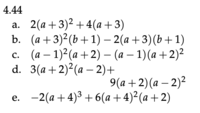ymathsohard
New member
- Joined
- Oct 5, 2020
- Messages
- 1
Hi everyone!! I'm new here, and I have the following burning math question:
I've recently introduced myself to factoring. I've been able to grasp the concept and am able to work out most (beginner level) problems. However, there are some problems in the book "All you need in Maths!" by dutch author Jan van de Craats that I just cannot figure. I'm not able to find any examples of these particular type of problems on Youtube or anywhere else on the web. So, hopefully you guys can help me out. Please find the problems in the provided image below (entire 4.44)
My main stumbling block is that I don't understand the underlying logic of how to do a step-by-step work out of these problems. I've looked at lessons about different factoring methods such as: factoring polynomials by grouping, AC method, factoring by finding the GCF; However none of these methods seem to give me the necessary tools/understanding to work the below problems. I've gone as far as looking at the special cases for factoring, and the below expressions in 4.44(image) do not qualify as perfect square trinomials, or are an expression of the difference of two squares.
Example of where I go wrong:
So I know that you start with factoring out the GCF. Makes sense, but which side of the equation do you eliminate the GCF. That is important in order to continue.
Anyway if anyone could please provide me with the underlying logic on how to approach these problems step-by-step, or maybe point me to some theory that I could read ?
Thank YOU SO MUCH

I've recently introduced myself to factoring. I've been able to grasp the concept and am able to work out most (beginner level) problems. However, there are some problems in the book "All you need in Maths!" by dutch author Jan van de Craats that I just cannot figure. I'm not able to find any examples of these particular type of problems on Youtube or anywhere else on the web. So, hopefully you guys can help me out. Please find the problems in the provided image below (entire 4.44)
My main stumbling block is that I don't understand the underlying logic of how to do a step-by-step work out of these problems. I've looked at lessons about different factoring methods such as: factoring polynomials by grouping, AC method, factoring by finding the GCF; However none of these methods seem to give me the necessary tools/understanding to work the below problems. I've gone as far as looking at the special cases for factoring, and the below expressions in 4.44(image) do not qualify as perfect square trinomials, or are an expression of the difference of two squares.
Example of where I go wrong:
So I know that you start with factoring out the GCF. Makes sense, but which side of the equation do you eliminate the GCF. That is important in order to continue.
Anyway if anyone could please provide me with the underlying logic on how to approach these problems step-by-step, or maybe point me to some theory that I could read ?
Thank YOU SO MUCH

